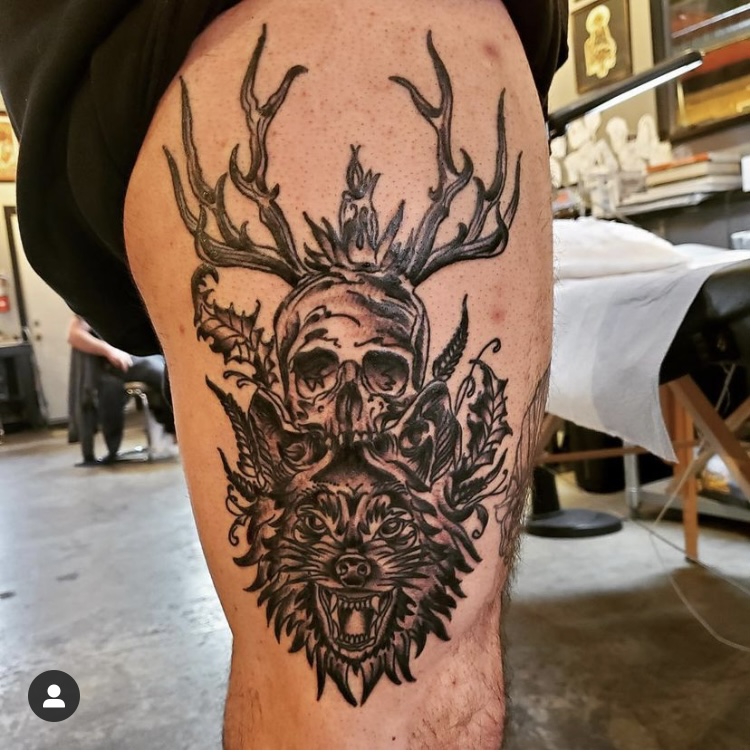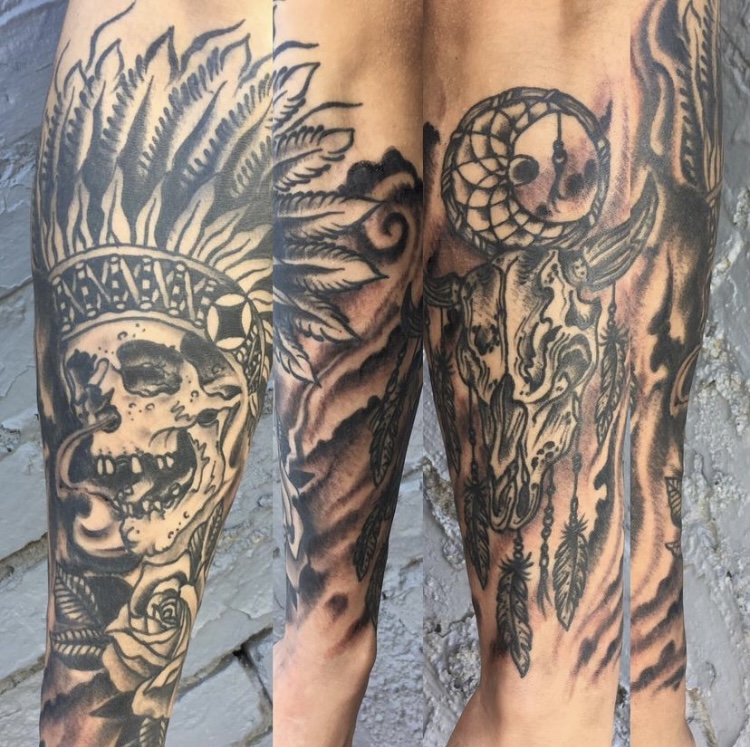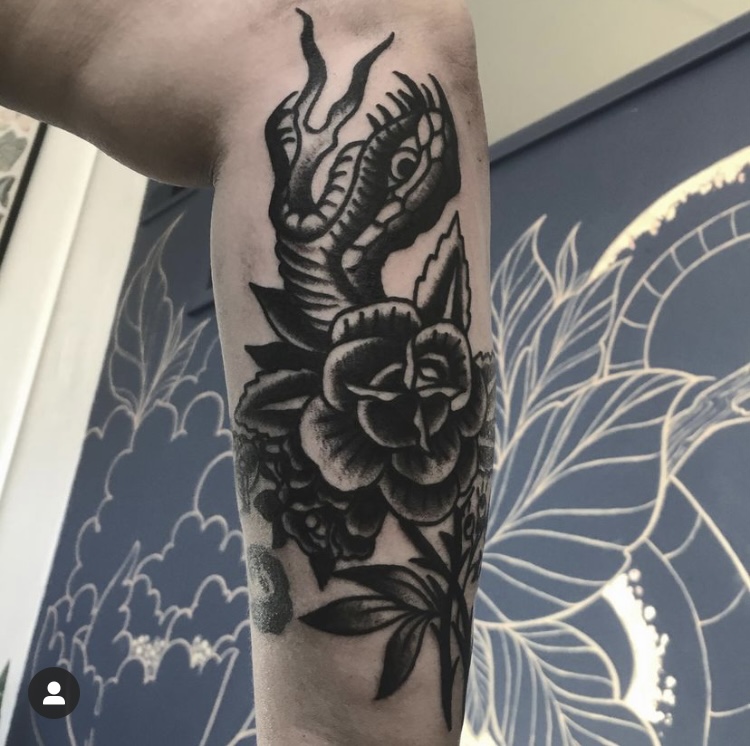
IN A NEW PHASE OF A LONG CAREER, AN OREGON-BASED TATTOOER PUTS AUTHENTICITY AND THE MAGIC OF THE ART FRONT AND CENTER
J.D. O’Kelly is a tattoo artist based in Portland, Oregon. Now 50 years old, he has witnessed many different aspects of tattooing as a business, as well as changing trends in “the industry,” as he calls it. Some of his observations are fresh and unexpected, and may sound somewhat contrarian. In fact, as an artist, it seems that, above all, it’s authenticity that O’Kelly — “J.D.” to those who know him — most values. Here, we present an interview conducted by Daniel Wojcik with J.D.
brutjournal contributor Daniel Wojcik is a professor at the University of Oregon in Eugene, where he specializes in folklore and mythology. He is the author of Punk and Neo-Tribal Body Art (University Press of Mississippi, 1995), Outsider Art: Visionary Worlds and Trauma (University Press of Mississippi, 2016), and the forthcoming monograph Artist as Astronaut: The Otherworldly Art of Ionel Talpazan, which will be published in the near future in the United Kingdom by Strange Attractor and distributed in the U.S.A. by MIT Press.
Daniel Wojcik: Initially, what attracted you to tattooing?
J.D. O’Kelly: When I was little, I had a G.I. Joe action figure with a tattoo on his chest —a Marines Corps insignia, with its eagle, globe, and anchor. I thought he looked like the toughest bastard ever. I also poured over Sgt. Rock comics. I grew up as a sickly child. Scared all the time. My mother was a way-over-the-top evangelical Christian. She once laid her hands on the TV set when it stopped working.

I was a bullied, artistic kid with a violent, macho, corporate-job dad. That kid had a fascination with noble tough guys. No one fucked with Sgt. Rock or with my G.I. Joe Marine action figure. On some level, I instinctively knew that what I needed was some kind of transformation but, of course, as a little kid, I couldn’t possibly articulate that feeling. I would frequently draw tattoos on my arms with Bic ballpoint pens. My nut-job mother made me wash them off and scolded me severely.
I was fascinated by the idea that tattoos were permanent. That blew my mind. Later, in high school, the bullying stopped after I spent a semester in weights class, working out. The redneck jocks saw that I was as strong as they were — with a physique.
I went on to study at the University of Oregon and was introduced to the punk-rock band Social Distortion, whose front man, Mike Ness, looked so fucking tough. I knew before I got my first tattoo that I would be getting sleeved, at a minimum. [Editor’s note: In tattooing jargon, a “sleeve” refers to an entire forearm, arm, calf, or leg that has been tattooed on all sides.]
I took your folklore classes [at the University of Oregon in Eugene] —“Folklore of Subcultures” and “Outsider Art” — and they blew my mind! Now I had a compass and a map, for tattooing was all of that wrapped up in one.
Tattooing had a secret history, outsider tendencies, and a material culture of old flash art [drawings of tattoo designs] and mystique-inducing tattoo machines and needle-making. It was a rich tapestry of lore, and it had been embraced by punk-rock rebels. I certainly was one — and I still am.
What made me want to be a tattooer? Naïveté and romanticism combined with a profound desire to transform myself into the opposite of a scared, sick little kid — in a world that’s still hostile to weirdo art people and outsiders.

I’ll add that the pain and the blood involved in tattooing sealed the deal for me. This wasn’t some art-gallery bullshit made safely in someone’s loft studio overlooking a now very white, urban-renewal community packed with “food options.” To me this was and is as real as it gets. Unless someone’s making paintings with their own blood, nothing else comes close.
Wojcik: Where did you study to become a tattoo artist and when did you start working professionally in this field?
O’Kelly: I learned from a mediocre individual who, in his own words, taught his students “just enough so he could still sleep at night.” He didn’t really teach me much of anything that prepared me for tattooing professionally at a busy street shop. My boss and the other seasoned artists there barely taught me anything either. They were all into “new school” tattoos, but I loved traditional Americana, or what some call “old school” tattoos, or as the Europeans like to call them, “Western traditional” designs.
Wojcik: What’s the difference between so-called new school and old school or traditional Americana-style tattoos?
O’Kelly: “New school” is known for its exaggerated features, with a heavy graffiti-and-anime influence and thick calligraphed lines but almost never any black shading of the kind you find in “old school” tattooing. The influence of a strong, comic-illustration, “realistic” quality is also visible in “new school” tattooing.
On the other hand, in the traditional style, you make all the lines and add black shading, and the tattoo should look finished. Then you add color.

I started my training just after the terrorist attacks of September 11, 2001 and got licensed in the spring of the following year. I started at the street shop and worked there for six years doing hokey designs on cheap, difficult people. Things have gotten better, but in some ways the tattoo scene hasn’t changed much. In fact, I’ve thought about leaving tattooing.
Too many people have watched too many tattoo reality shows, or went tanning with a Playboy-bunny cutout placed low on the front of their hips so that, you know, when they meet you and ask to be tattooed, they can let you know exactly where to tattoo them, and it pretty quickly kills that inexplicable something that first attracted me to tattooing — an archetypal, ritualistic, liminal, transformative, quasi-shamanistic buzz about it all.
Today, social-media influencers have asserted themselves and reshaped the industry, which is now influenced from the outside in.
Wojcik: Please explain what you mean by that remark.
O’Kelly: Thanks to influencers and younger artists who are also influencers, many new tattooers don’t follow any of the profession’s old rules or codes. Before all the Instagrammers entered the picture, no respectable artist would have put a hand or neck tattoo on someone who wasn’t already heavily and visibly tattooed — at a minimum, a customer would have had to have sleeves. Because only then could the person receiving such a tattoo begin to fathom the impact the stigma of having it would have on his or her life.
Believe me, that stigma is still very real.
But these kids, they open up shops right on top of those of older tattooers who are already well established. That’s bad etiquette. And they’ll tattoo palms, hands, necks. They don’t care, as long as it can become a postable moment that will make them look cool on Instagram. There’s a joke term for these people’s tattoos: “Vans Warped Tour Body Suit,” referring to hands blasted, neck and throat blasted, lower forearms blasted. Take off the T-shirt, and the person has no other tattoos anywhere. I may not know what authentic is but I know that that isn’t. These days, there is intense competition among those who are trying to make a living as tattooists. If you tell hipsters they’re not yet tattooed enough to receive neck tattoos, they’ll just walk a block or two away and get it done by someone else.

Wojcik: Professionally and personally, where are you today?
O’Kelly: After 20 years in the business and now, living with fibromyalgia [chronic pain, tenderness, and stiffness of certain muscles and connective tissues], I’ve decided to create a private studio in an old recreational-vehicle trailer and give priority to my own, original designs. I’ll open up books containing my designs every two to three months or so, invite customers to submit their ideas about which designs they might like to be tattooed with, and then I’ll pick what I find most appealing. I used to feel envious and think that it was pretentious when I saw other artists doing this kind of thing, but at this point, I’m looking forward to an opportunity to bring a certain dignity and the magic back to the tattooing experience — with a super-low profile, as an industry outsider located even farther outside the center of the industry. That’s where I tend to thrive.
I have zero desire to be involved in the tattoo industry anymore. It kind of got in the way of what I really value about tattooing — the archetypal, liminal/sacred, quasi- or overtly shamanistic aspects of tattooing, and doing meaningful work, not just pop-culture nonsense and the crap people bring in after looking at Pinterest.
With my wife, Julie O’Kelly, I’m also working on different creative pursuits, from making coffins to upcycling vintage and gothic furniture. People have responded very favorably to our Etsy store, Immortal Curio Furniture Company. I’m planning to leave tattooing completely by the time I’m 60.
Wojcik: In the United States today, what’s the price range for tattooing services?
O’Kelly: From one-eighth an ounce of weed and a 40-ounce bottle of your favorite malt liquor at your average underground scratcher den to over $500.00 an hour in your latest Instagram darling’s star-studded realm.
Price in no way indicates quality. Some of the biggest names in the business are absolutely terrible at execution and design, while some underground tattooers are actually very capable.
Wojcik: Earlier, you mentioned punk rock. Has it influenced your approach to tattooing?
O’Kelly: Initially, yes, it did. The minimalism of traditionalist tattoos goes hand in hand with the hardened noir vibe of late-20th-century punk rock. Think the Stooges, Agent Orange, Exploited, or the British band GBH.
However, in recent years, dark, neo-pagan, black-metal, Goth, and post-punk sensibilities have obliterated punk for me. Punk is too limited, too grounded in this moment. Other styles and subcultures speak to broader mythological and psycho-spiritual realms.
Wojcik: Do you have any thoughts on outsider art in relation to tattooing?
O’Kelly: It’s difficult to see contemporary tattooing as outsider art. I think that, in the past, there was an outsider aspect to tattooing, and certainly today, outside of Portland, Eugene, New York, San Francisco, and some other urban areas, tattooing is still viewed as questionable by mainstream squares. But even before the era of electric tattooing in the early 1900s, tattoo artists had shops and tattooed for money. It was a business, but trade secrets were very protectively guarded.
A fella could find himself badly beaten up if he went into a shop to steal design ideas or if he asked too many questions about the tattoo process. I think that, because tattooing was not accepted by the mainstream, tattoo artists had to look after their own and didn’t want the outside world peeking its nose in.

Signs of outsiderness exist within the industry wherever you find tattooers who lack formal training, and even though tattooing is big with the mainstream now, one has to look at the different genres and who they appeal to. Barrio style single needle; portrait style; old school; Japanese; metal style; biker style; queer style; etc. One of the main unifying themes among all the genres is iconography. Images are still shorthand signifiers. A lot of people who may have wanted to get tattooed before but felt held back by society’s mores are now stepping into it.
With tattooing, there seems to be a middle-ground person who is a sort of participant-observer — the customer who is savvy and travels comfortably between the mainstream and the tattoo worlds. Such customers are usually aficionados who have a pretty sophisticated understanding of what they want and of what’s going on in tattooing at any given time.
Being a romantic, I’d love to think of tattooing as being at least at some point in world history a brilliant form of outsider art. It has always existed in some multiple, personal-cultural context, whether it has been done for money or not. It’s that context that has given tattooing its meaning within a given culture. That makes it a different beast than outsider art.
What I find most inspiring about art brut and outsider art is these genres’ undeniable lack of domestication. Domestication is death for any artist. Some of us may have started out as exiles, but at some point, exiles become expats. That’s the point at which one embraces one’s liminal or outsider status. To capitulate to mainstream values is self-betrayal; it’s giving in to an untruthful, inauthentic existence.
Trying to make oneself understood by society? It’s society that needs to try to understand the artist. Society needs to show the minimal courtesy and put in some work itself. The jury is out as to whether that has ever really happened — or if it ever will.
There will always be genuine outsiders. The nut jobs, the weirdos, the addicts. To me, they represent some kind of real relevance, where flesh and blood meet the reality of living one’s ideals or vision.
Resources
The tattoo artist J.D. O’Kelly maintains two Instagram accounts:
@thistlewulf
@immortal_curio_company
J.D. O’Kelly and Julie O’Kelly’s Immortal Curio Furniture Company page on the Etsy website:
https://www.etsy.com/shop/ImmortalCurioCompany



